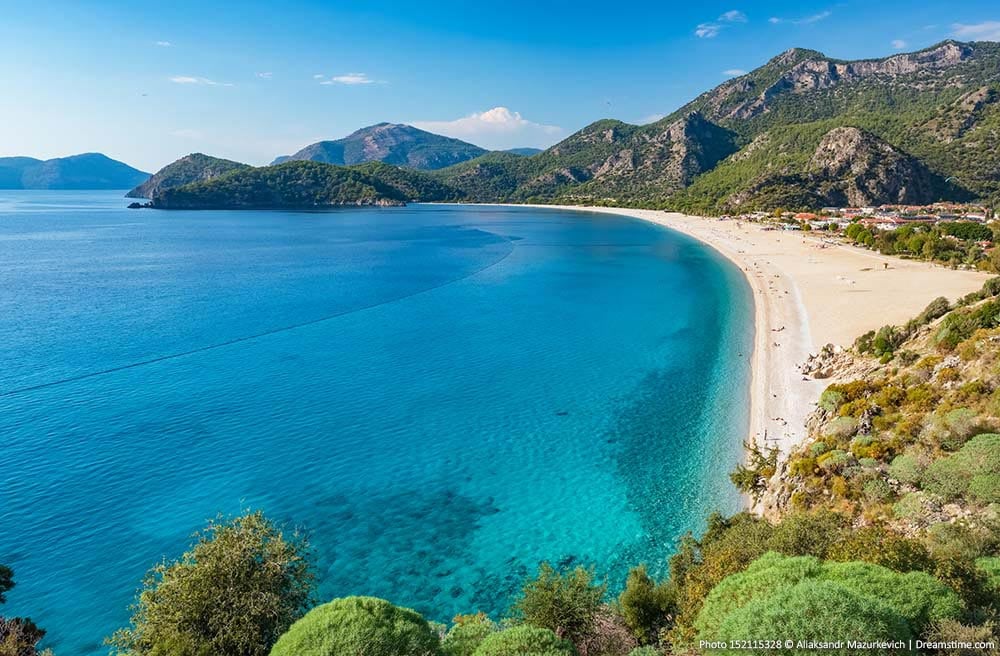Turkey’s Turquoise Coast, also known as the Turkish Riviera, is one of the most beautiful and captivating stretches of coastline in the world Located along the southwestern coast of Turkey, where the sparkling Mediterranean and Aegean seas meet, this lush region is renowned for its stunning beaches, ancient ruins, charming towns, and abundance of natural beauty
But where exactly is the Turquoise Coast located? And what are the best places to visit during a trip there? In this complete guide, we’ll explore where you can find this famous Turkish coastline and highlight some of the top destinations and attractions that make it such a magical Mediterranean escape.
Overview of the Turquoise Coast
The Turquoise Coast spans roughly 300 miles of Turkey’s southwestern coastline, encompassing parts of the Antalya Muğla, Aydın İzmir, and Mersin provinces. It runs from the town of Marmaris in the west to the city of Alanya in the east.
Some of the most popular and scenic sections of the coast include:
-
The Bodrum Peninsula – A sophisticated peninsula known for beautiful beaches, luxury resorts, yacht marinas, and lively nightlife. Major destinations include the port city of Bodrum, and the towns of Turgutreis, Yalıkavak, Gümüşlük, and Bitez.
-
Fethiye and Ölüdeniz – Home to scenic Fethiye Bay, the famous Blue Lagoon of Ölüdeniz, and amazing opportunities for paragliding off the summit of Mount Babadağ.
-
The Gulf of Gökova – A tranquil gulf with small seaside villages, secluded coves, and the ruins of ancient settlements.
-
Dalyan – A lush river delta with stunning rock tombs, hot springs, and Iztuzu Beach, where endangered loggerhead turtles come to nest.
-
Kalkan & Kaş – Charming former fishing villages known for Mediterranean flavor, small boutique hotels, and excellent scuba diving.
-
Kekova Bay – Dotted with picturesque islands and home to the Sunken City of Kekova, an ancient Lycian town that’s now partially submerged underwater.
-
Antalya – Turkey’s largest city on the Mediterranean coast, serving as the eastern gateway to the Turquoise Coast, with an atmospheric Old Town district.
Top Destinations and Attractions on the Turquoise Coast
Bodrum Peninsula
The Bodrum Peninsula extends out into the Aegean Sea from the city of Bodrum, creating a scenic 40 mile coastline dotted with charming villages, secluded bays, luxury hotels and excellent dining.
Bodrum is the largest city and the peninsula’s beating heart. Wander through the atmospheric lanes of the Old Town, visit the imposing Crusader castle, and enjoy fresh seafood by the marina. The city also has an energetic nightlife scene.
Yalıkavak has a quaint harbor lined with upscale restaurants and art galleries. Nearby, the former Greek village of Gümüşlük exudes laid-back charm with its seaside cafes and ancient ruins.
Turgutreis has the longest beach on the peninsula and a lively bazaar, while food and art lovers flock to Gümüşlük for its weekly market and bohemian vibe.
Fethiye & Ölüdeniz
Located on the site of ancient Telmessos, the lively port town of Fethiye serves as the gateway to some of the Turquoise Coast’s most spectacular scenery. The stunning Ölüdeniz Lagoon is one of Turkey’s most photographed destinations, with its calm turquoise waters set against the backdrop of soaring mountains. Many visitors enjoy tandem paragliding off the summit of nearby Mount Babadağ for panoramic coastal views.
The ghost town of Kayaköy, nestled in the hills above Fethiye, provides a fascinating look into history. This former Greek village was abandoned after WWI and left remarkably intact.
Kalkan & Kaş
The once-sleepy fishing villages of Kalkan and Kaş have evolved into sophisticated resort destinations known for small boutique hotels, outdoor adventures, and charming Ottoman architecture.
Kalkan cascades down a hillside towards a peaceful harbor dotted with al fresco restaurants. Nearby Patara Beach offers 18kms of pristine golden sand backed by sand dunes, while the fascinating ruins of Ancient Xanthos and Letoon are a short drive away.
In Kaş, cobblestone streets are lined with colorful shops and cafes interspersed with Lycian rock tombs. It’s one of the region’s top diving destinations, with excellent underwater visibility. Nearby day trips include the gorgeous Kekova Bay and the mountain village of Saklikent Gorge.
Dalyan
Situated on the Dalyan River delta, Dalyan is surrounded by dramatic landscapes including the ancient rock tombs of Dalyan’s Kings, hot springs, and dense riverfront vegetation. One of the most scenic ways to explore is on a riverboat, drifting past the rock tomb facades and stopping to swim in hidden coves.
Dalyan is also renowned for Iztuzu Beach, where endangered loggerhead sea turtles come ashore to lay their eggs during the summer months. This long swath of golden sand is routinely voted one of the world’s finest natural beaches.
Antalya & Alanya
Found at the eastern extent of the Turquoise Coast, Antalya and Alanya differ from the cozy towns farther west. With over 2 million residents, Antalya is a major city, but still boasts remarkable scenery including dramatic waterfalls and opportunities for hiking in the nearby Taurus Mountains. Its picturesque Old Town of Kaleiçi wraps around a Roman-era harbor.
Alanya originated as a seaside fortress and trading post. Today it’s known for the 13th century Alanya Castle perched on a rocky promontory overlooking Cleopatra Beach, and the famous Damlataş Cave filled with stalactites and stalagmites.
Experiencing the Turquoise Coast
With so much diversity stretched along its shores, the Turquoise Coast offers endless options for creating your own Mediterranean escape. Spend laid-back days beach-hopping and swimming in crystalline coves, squeeze in a few rounds of golf on resort courses overlooking the sea, or charter a yacht to explore secluded bays and islands.
Inland adventures include trekking along the iconic Lycian Way that follows old footpaths above the coast, rafting down mountain rivers, or watching the sunset from hilltop ruins. For a dose of culture, wander through ancient amphitheaters and rock-cut tombs before feasting on fresh seafood along a lively harborfront.
One of the joys of traveling in this region is choosing your own mix of vibes, scenery and activities. Quaint villages, major cities, ancient sites, and unspoiled nature – the Turquoise Coast truly offers it all.
Planning Your Visit
When to Go
The Turquoise Coast enjoys mild, sunny weather much of the year, making it a popular escape even during the colder months. Peak tourist season runs from mid-June through August. For smaller crowds and lower hotel prices, visit during the shoulder seasons of May and September.
Getting There
The region is easily reached by air, with flights available to international airports in Bodrum, Dalaman and Antalya from major European cities. Transfers or renting a car at the airport provides maximum flexibility for exploring the coast.
Long-distance buses also frequently link towns along the coast and run to/from Istanbul and other Turkish cities.
Getting Around
Driving allows the most freedom, especially for traveling between destinations and visiting inland sites. Roads are well-maintained and signposted along the coast. Rental cars are readily available.
For hopping between coastal towns, dolmuş minibuses provide reliable public transport. In cities like Bodrum, Antalya and Fethiye walking and taxis are ideal. Boat trips link some villages and islands.
Where to Stay
Accommodation runs the gamut from luxury beach resorts to family-run pensions. For authentic local flavor, smaller villages away from major cities provide charming lodging options, though amenities are fewer. Booking hotels in advance is recommended during the busy summer season.
Must See Ancient Sites
No visit to the Turquoise Coast is complete without taking in remnants of the Lycians, Greeks, Romans and Byzantines who once populated the region:
- Bodrum Castle
- Termess

Plan with a local

Discover Turkey’s Turquoise Coast
FAQ
What is the nearest airport to the Turquoise Coast in Turkey?
Is Bodrum part of the Turquoise Coast?
Where is the bluest water in Turkey?
Where is Turkey’s Turquoise Coast?
However, head slightly east and you’ll find Turkey’s aptly nicknamed turquoise coast. Stretching from Fethiye to Antalya, this stretch of coastline contains not only gorgeous beaches but ancient ruins and plenty of opportunities for activities from hiking to diving.
Can you visit Turkey’s Turquoise Coast by land and sea?
You can visit Turkey’s Turquoise Coast by both land and sea, and with so much on offer, it’s easy to see why the Turkish Riviera is the perfect place for any traveler. Here is everything you need to know about visiting this beautiful coast by sea and land. You have many cities and hidden gems to uncover on the coast of Turkey.
How to see the Turquoise Coast?
One of the best ways to see the Turquoise Coast is by sailing. With waters along the Mediterranean Coast as well as the Aegean Coast and beautiful crystal clear waters, the Turkish Riviera is the perfect place for a sailing holiday.
Why is Turkey called the Turquoise Coast?
Plan my trip ⤍ Noted for its fine beaches and stunning mountainous scenery, Turkey’s southwesternmost shore has long been dubbed “the Turquoise Coast”, thanks to the hues of its horizons and the sea. It’s dominated by the Baba, Akdağ and Bey mountains, which drop precipitously to the main coastal highway that often skims just above the water.
